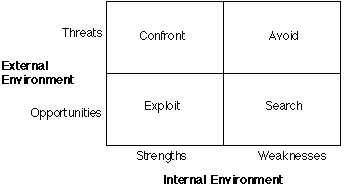SWOT (Strengths, Weaknesses, Opportunities, Threats)

A SWOT analysis helps find the best match between environmental trends (opportunities and threats) and internal capabilities.
- A strength is a resource or capacity the organisation can use effectively to achieve its objectives.
- A weakness is a limitation, fault, or defect in the organisation that will keep it from achieving its objectives.
- An opportunity is any favourable situation in the organisation's environment. It is usually a trend or change of some kind or an overlooked need that increases demand for a product or service and permits the firm to enhance its position by supplying it.
- A threat is any unfavourable situation in the organisation's environment that is potentially damaging to its strategy. The threat may be a barrier, a constraint, or anything external that might cause problems, damage or injury.
In general, an effective strategy is one that takes advantage of the organisation's opportunities by employing its strengths and wards off threats by avoiding them or by correcting or compensating for weaknesses.
The first part of any SWOT analysis is to collect a set of key facts about the organisation and its environment. This will include facts about the organisation's markets, competition, financial resources, facilities, employees, inventories, marketing and distribution system, R&D;, management, environmental setting (e.g. Technological, political, social, and economic trends), history and reputation.
The second part of a SWOT analysis is to evaluate data to determine whether they constitute strengths, weaknesses, opportunities or threats for the organisation. This may be done independently by the individuals in a group, results being compared afterwards. It is important to note that any given fact may give rise to more than one evaluation, and so to ask - " How may this fact be considered as an opportunity as well as a threat?"; "How may this apparent strength turn out to be a weakness?"; "How does this weakness really represent a strength?" The answers to these and similar questions may give managers new insights into choosing appropriate strategies.
References
- Rowe, Mason, Dickel, Mann, Mockler; "Strategic Management: a methodological approach". 4th Edition, 1994. Addison-Wesley. Reading Mass.









